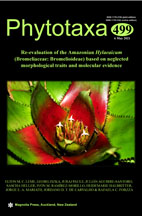Abstract
Generic status for the Amazonian Hylaeaicum is proposed within the Aechmea alliance, excluding it from the “Nidularioid complex” in general and from Neoregelia in particular. The monophyly of this new genus is supported by molecular phylogenetic analyses. The taxonomic circumscription of Hylaeaicum is based on the combination of geographical range and morphological characters, such as clonal growth, inflorescence structure, petal and corolla conformation, petal appendages, ovary, ovule, stigma, pollen, fruit, and seed, as well as seed anatomy, thoroughly documented and illustrated from field-collected specimens that flowered in cultivation in the Rio de Janeiro Botanical Garden, the Marie Selby Botanical Gardens, and in Refúgio dos Gravatás. The presence of seeds with long bicaudate appendages on both chalazal and micropylar ends is reported for the first time in Bromelioideae and considered an important character to distinguish Hylaeaicum from the related genera in the Aechmea alliance. In order to support the morphological distinctness of Hylaeaicum, the most varied and complete documentation of stigmata, fruits, and seeds of Bromelioideae is also presented for the first time, covering 24 genera and 17 subgenera. Fourteen new combinations, including 12 species and two varieties, are proposed.

